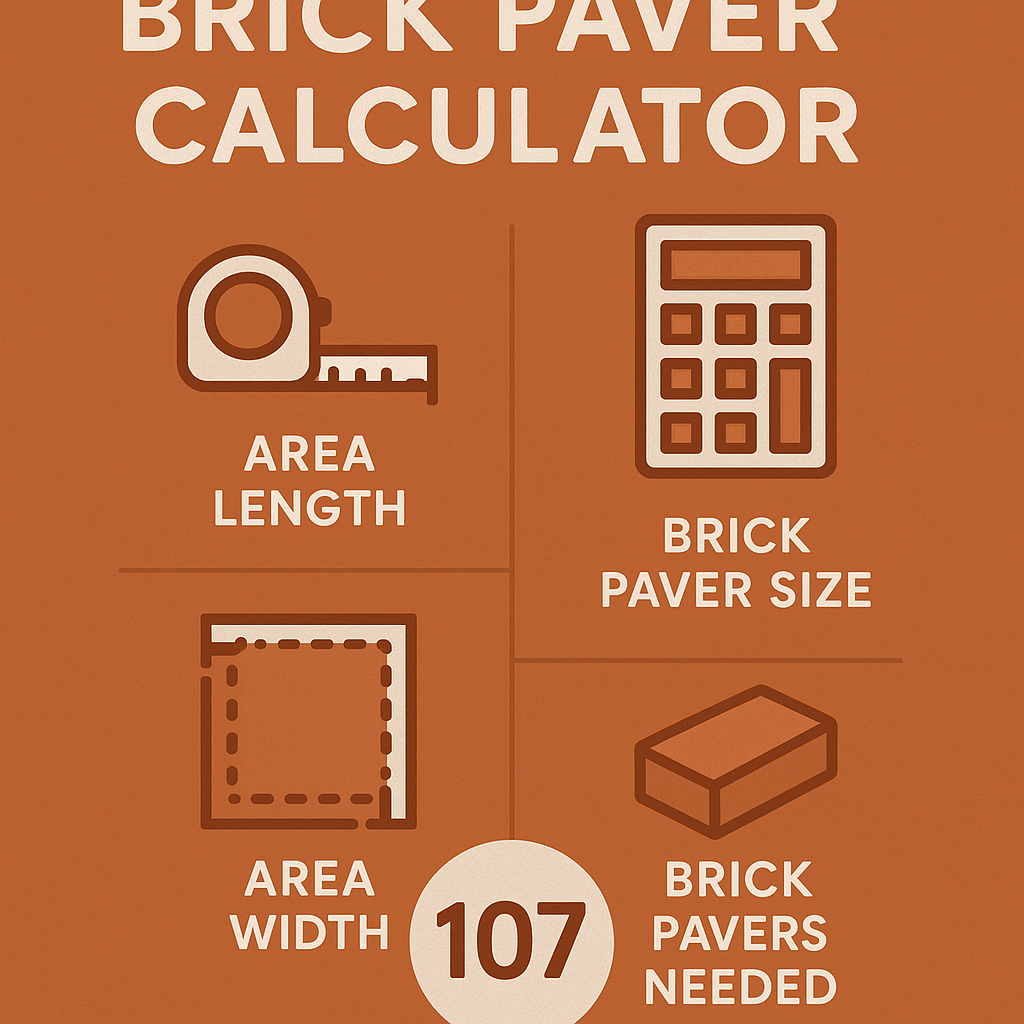Free Brick Paver Calculator Online
Installing a patio, walkway, or driveway with brick pavers requires precise planning—especially when it comes to how many pavers you’ll need. Whether you’re laying a small backyard path or a large outdoor entertainment space, getting the numbers right is crucial to avoid waste or shortages. The Construction Calculators site features a Brick Paver Calculator that helps you quickly determine how many bricks to order based on your project’s total area, chosen pattern, and paver size—streamlining the planning process and saving time on the job.
What Is a Brick Paver Calculator?
A Brick Paver Calculator is a construction planning tool that estimates the number of pavers needed to cover a specific area. By entering the total square footage of the surface and the dimensions of the brick, the calculator determines the quantity of bricks required including extra for cuts and waste.
Contractors and homeowners use this tool to reduce material waste, save time, and avoid over-ordering or multiple trips to the supplier.

Why Accurate Paver Estimation Matters
Laying pavers is not just about looks it’s about function and precision. Miscalculating brick quantities can lead to delays, inconsistent layouts, and added costs. Here’s why a brick paver calculator is essential:
- Prevents material shortages or overstocking
- Helps budget properly for material costs
- Reduces labor interruptions
- Accounts for waste due to cutting or breakage
- Supports efficient layout planning based on brick patterns
How to Use the Brick Paver Calculator
To calculate how many pavers you need, you’ll input the following:
- Project area dimensions (length × width)
- Paver size (length × width)
- Waste percentage (usually 5–10%)
The calculator returns the total number of bricks needed to cover the area, accounting for spacing and pattern layout.
Example Calculation
Let’s say you’re paving a patio that’s 12 feet wide by 15 feet long, using bricks that are 4″ × 8″ in size.
Step 1: Calculate the Area of the Surface
$$[
\text{Patio Area} = 12 \text{ ft} \times 15 \text{ ft} = 180 \text{ sq ft}
]$$
Step 2: Convert Brick Size to Square Feet
4″ × 8″ = 0.33 ft × 0.67 ft = 0.2211 sq ft per paver
Step 3: Divide Total Area by Paver Size
$$[
\frac{180}{0.2211} \approx 814 \text{ pavers}
]$$
Step 4: Add Waste Factor (10%)
$$814 \times 1.10 \approx 896 \text{ total pavers}$$
So, you’d need approximately 896 pavers for the project.
Standard Paver Sizes and Coverage
| Paver Size (inches) | Pavers per Sq Ft | Sq Ft per 100 Pavers |
|---|---|---|
| 4″ × 8″ | 4.5 | 22.2 |
| 6″ × 6″ | 4.0 | 25.0 |
| 6″ × 9″ | 2.7 | 37.0 |
| 12″ × 12″ | 1.0 | 100.0 |
Use these as a quick reference for basic estimations before running the calculator.
Patterns and Layout Impact
The way you lay bricks affects how many you’ll need:
- Running bond (staggered rows)
- Basket weave
- Herringbone (45° or 90°)
- Stack bond (lined up grid)
Some patterns result in more waste due to angled cuts or border gaps. The calculator allows for this by adjusting the waste percentage.
Materials to Include in Your Estimate
Besides the pavers themselves, make sure to calculate materials for:
- Base material (gravel or crushed stone)
- Sand bedding layer
- Joint sand or polymeric sand
- Edging restraints
Although the brick paver calculator focuses on the pavers, companion calculators for gravel and sand can help you plan a full installation.
Best Practices When Ordering Pavers
- Measure Twice: Confirm your area dimensions for accuracy.
- Round Up: Always order slightly more than needed.
- Match Lots: Buy all pavers from one batch to avoid color variation.
- Dry Fit First: Test the layout before final installation.
- Check for Delivery Time: Special patterns or colors may take longer to arrive.
Frequently Asked Questions
How many pavers do I need for 100 square feet?
It depends on paver size. For standard 4″ × 8″ bricks:
- One paver covers 0.2211 sq ft
- 100 ÷ 0.2211 = ~452 pavers
- Add 10% waste = ~497 pavers
How much waste should I account for?
Plan for 5% waste on simple rectangular patios. For complex layouts, curved edges, or patterns like herringbone, allow 10–15%.
Can I mix paver sizes?
Yes. Patterns like ashlar or random layouts mix different sizes. Use a calculator that supports modular paver sets for best results.
Do I need spacers between pavers?
Most dry-set brick pavers are laid tight together with small gaps filled by sand. Some types, like interlocking concrete pavers, have built-in spacers.
Should I compact the base before installing pavers?
Absolutely. A compacted base is critical to prevent shifting, sinking, and uneven surfaces over time.
Related Construction Calculators
- Gravel Calculator – For estimating base layer volume
- Sand Calculator – For bedding and joint sand
- Concrete Volume Calculator – For poured borders or pads
- Slab Thickness Calculator – To compare concrete vs. paver build-ups
- Paver Edge Calculator – For border trim lengths
Conclusion
The Brick Paver Calculator is your go-to tool for planning successful outdoor paving projects. It takes the guesswork out of estimating, helps you avoid costly mistakes, and gives you the confidence to purchase the right quantity of materials from the start. Found on the Concrete Calculators platform, it works seamlessly with other tools like the Epoxy Calculator for finishing surfaces and the Paver Calculator for broader hardscape planning—making it easier to complete your project on time, within budget, and with precision.
Before you begin your project, take the time to calculate accurately, choose your paver pattern, and plan for a smooth installation process. Whether it’s a patio, walkway, or driveway, the right number of pavers and a solid plan make all the difference.
